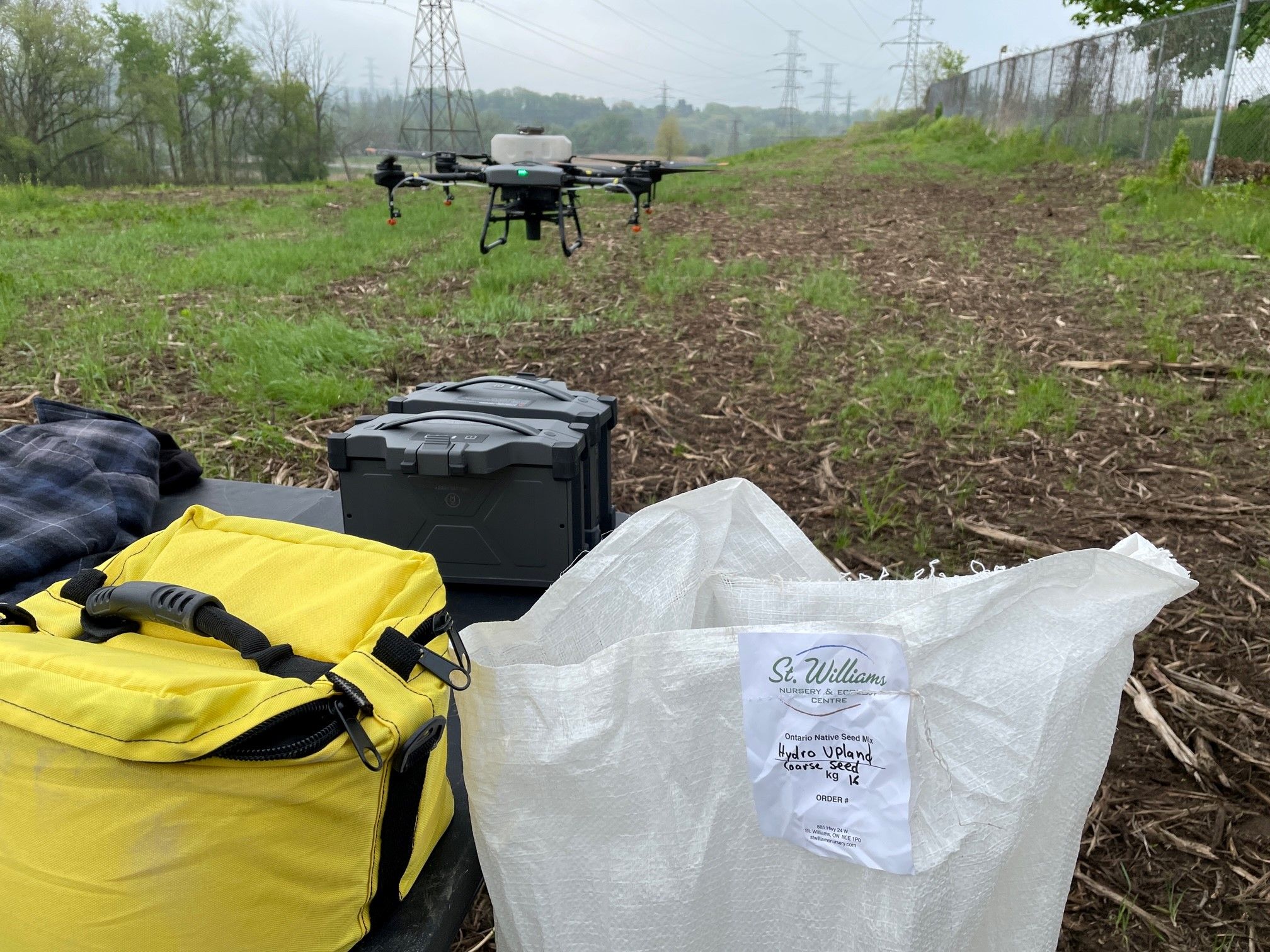

The Royal Botanical Gardens (RBG) has connected people to the plant world for over eight decades. RBG collaborated with the Unmanned and Remote Sensing Innovation Centre (URSIC) to experiment with strategic seeding using an aerial drone to prevent plant overgrowth in a hydro corridor.

Funder: Kenneth M. Molson Foundation
Research Area: Unmanned & Remote Sensing
Research Team: Richard Borger, Matthew Shelley, James Kretz
Future Ready Challenge
Hydro corridors often run through remote and rugged areas. The natural growth occurring in these corridors must be maintained as grassy or brushy growth to avoid trees reaching the high voltage wires above.
Hydro corridors generally cut across vegetated areas and represent an opportunity to maintain native grassland habitats. In these cases, strategic seeding of small sized plant species can reduce corridor maintenance frequency, and can promote the regrowth of native grasses, wildflowers, and small shrubs. However, seeding a large hydro corridor of crossing rugged terrain using traditional methods is time-consuming, inefficient, and can be extremely difficult due to access challenges.
R & D Collaboration
Royal Botanical Gardens (RBG) in Hamilton, Ontario is the largest botanical gardens in Canada. Several regional hydro corridors run through the environmental conservation area of the property, and when the land is disturbed or cut back, strategic grassland reseeding is the preferred approach to re-establish the native vegetation. Projects of this theme are emerging due to the scarcity of native plant based grasslands in southern Ontario and an organization called Grasslands Ontario was initiated in 2021. Hand-seeding cleared land through rough, furrowed terrain with unusually shaped and sized native plant seeds requires a large team and significant time investment. Since traditional methods were not feasible, RBG asked researchers from the Unmanned and Remote Sensing Innovation Centre (URSIC) to experiment with seeding a hydro corridor on the property using an aerial drone designed for agricultural use.
The Kenneth M Molson Foundation, which focuses on wildlife research and conservation of habitats along with aeronautical engineering education and research, funded this project. This partnership with the RBG and URSIC successfully incorporated the goals and interests of each party.
Innovative Results
Mohawk’s URSIC partnered with Royal Botanical Gardens and St. Williams Nursery & Ecology Centre to re-seed four hectares of hydro corridor that had been ground to raw soil by large machinery, with a diverse mix of native grassland species (grass and wildflowers). URSIC used an agricultural drone, designed designed to distribute a single plant species, and that created the principal challenge, which was to determine how to best handle a diverse mixture of seed sizes, shapes, and weights, including establishing if this approach was even possible.
The hydro corridor used for this project crosses the north side of Cootes Paradise a 600-hectare nature sanctuary established in 1927. Due to the significance of this sanctuary for migratory birds, it was extremely important to encourage regrowth of the hydro corridor in an ecologically responsible way particularly as its an opportunity to host endangered grassland bird species. After procuring a site appropriate custom seed blend of native grasses and wildflowers from St. Williams Nursery & Ecology Centre, Royal Botanical Gardens and URSIC team were ready to begin.
The URSIC team used a DJI Agras T10 Remotely Piloted Aircraft (RPA), with a spreader system from OmniView Tech. After experimenting with various settings, the team discovered that a modified version of the “rice” setting allowed for the optimal spread pattern with the native seed blend. Since the native seeds were less smooth and more lightweight than rice, URSIC achieved actual seed coverage of approximately 9 kilograms of seed per hectare. After loading the seed into the RPA, the drone was able to cover the entire four hectares in only two hours. The alternate of hand seeding would have required 4 people and a day of work along with scrambling over ground up tree roots and vehicle ruts. The ultimate success of re-establishing the native grassland plant species will take several years before it is developed and mature.
“The URSIC team at Mohawk College provided an excellent solution to our needs and helped us re-establish native growth in a disrupted area of Cootes Paradise. We are looking forward to a more sustainable grassland habitat in the coming years,” said Tys Theijsmeijer, RBG Head of Natural Areas.

